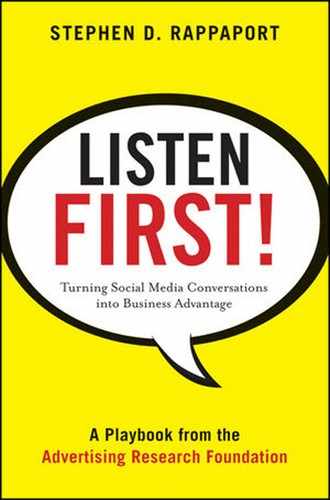Part III
Listening-Led Marketing and Media Innovations
Ask the average marketing person what social media listening is best suited for, and you'll hear “insights and customer service—it's the world's largest focus group!” That's only partially true, of course, and we hope it's a notion this book has already dispelled. What is considerably lesser known is our ability to use listening to transform soft conversations into hard data, as well as for a wider variety of business-building purposes. The four chapters in this part analyze innovative applications for listening data in media and marketing:
Social TV Measurement (Chapter 15) has been developed to evaluate viewer interest in programs. These go beyond measuring mere audience size to assessing audience engagement and intention for media strategy, planning, and buying. These tools are already changing ideas about the programs in which brands should advertise or use for product placement.
Listening-Based Targeting (Chapter 16) uses people's conversations and media behavior to identify potential audiences via techniques like text mining, content analysis, and trend watching. These methods are especially valuable for uncovering multicultural markets, locating people who discuss common interests, and developing language-based segmentations.
Achieve Share of Market Goals (Chapter 17) explores the relationship between share of conversational voice and share of market. This approach aspires to extend the traditional advertising voice/share of market into the social media realm, and understand it through listening. Although it's clearly still an emerging area, the evidence we've gathered suggests that market share and conversational share of voice are correlated: Leading brands have the largest share of voice; the second brand has the second largest; and so on. Just as conventional research does, this trend may provide advertisers and marketers with guidelines for maintaining or growing market share and developing strategy and budget. It can also allow brands to reap the benefits inherent in larger market shares, such as greater cost-efficiency, customer preference, and trade clout.
Listening-Based Sales Predictions (Chapter 18) reflect new approaches to forecasting near-term changes in sales. This chapter goes into detail on the many conversation factors that impact sales, and the various types of predictive models that were built from those elements. Instead of just being number generators for CFOs, the models become templates for planning and strategy because they reflect what is important to people buying particular products and services. Features that improve sales in prediction models are factors that companies can optimize in marketing and advertising. This could be thought of as suggesting a new marketing discipline: “prediction-led strategy.”
Of one thing we can be certain: these four applications are only a beginning.
